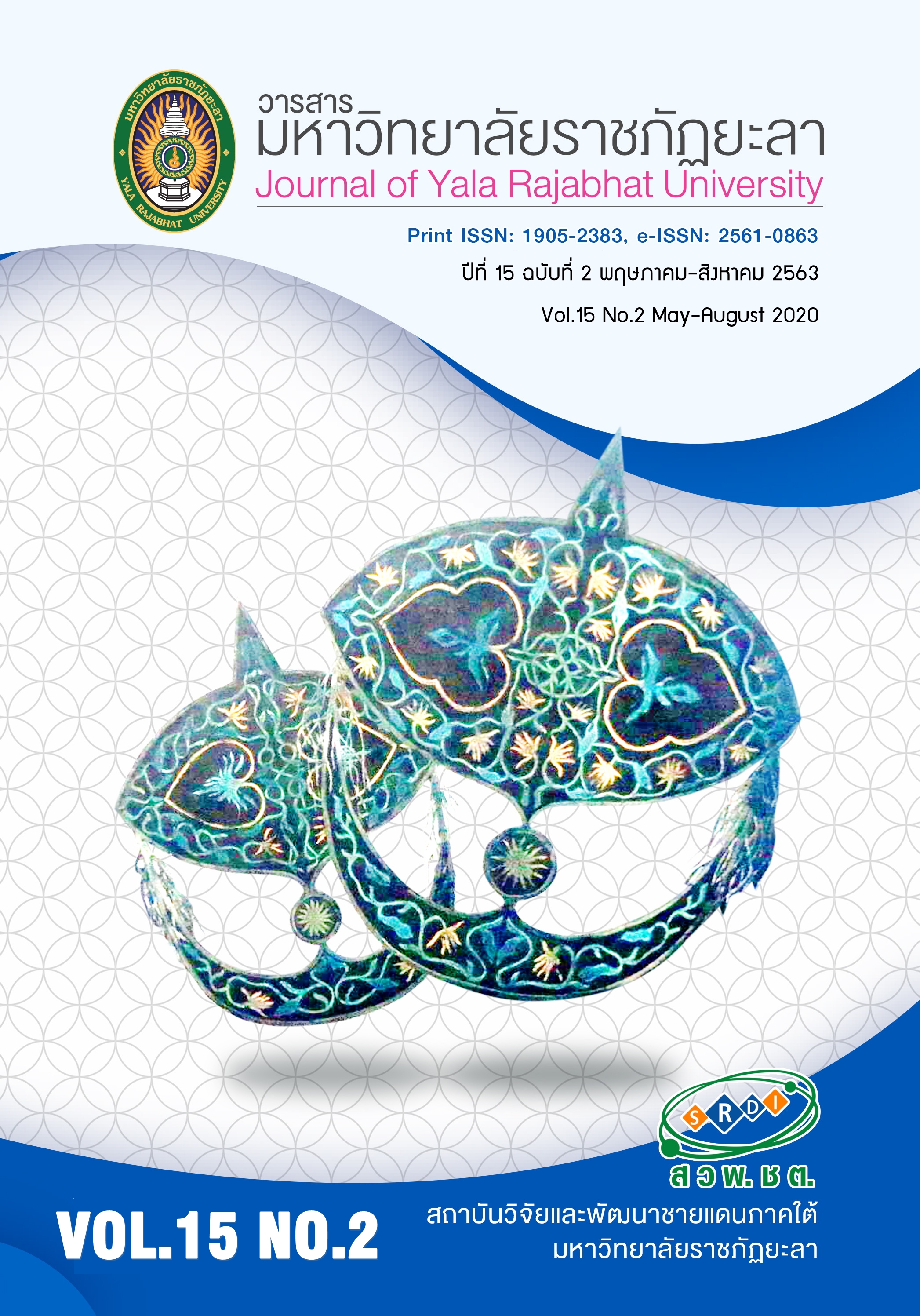การใช้กิจกรรมผังความสัมพันธ์ทางความหมายเพื่อส่งเสริมความสามารถในการอ่าน การเขียน และความรู้คำศัพท์ภาษาอังกฤษของนักเรียนชั้นมัธยมศึกษาปีที่ 1
Main Article Content
บทคัดย่อ
การวิจัยในครั้งนี้มีวัตถุประสงค์เพื่อ 1) เปรียบเทียบความสามารถในการอ่านภาษาอังกฤษของผู้เรียนก่อนและหลังการเรียนโดยใช้กิจกรรมผังความสัมพันธ์ทางความหมาย 2) ศึกษาความสามารถในการเขียนภาษาอังกฤษของผู้เรียนหลังการเรียนโดยใช้กิจกรรมผังความสัมพันธ์ทางความหมาย และ 3) เปรียบเทียบความรู้คำศัพท์ภาษาอังกฤษของผู้เรียนก่อนและหลังการเรียนโดยใช้กิจกรรมผังความสัมพันธ์ทางความหมาย รวมทั้ง กลุ่มตัวอย่างที่ใช้ในการวิจัยครั้งนี้เป็นนักเรียนชั้นมัธยมศึกษาปีที่ 1 โรงเรียนวัดแม่แก้ดน้อย ที่เรียนวิชาภาษาอังกฤษพื้นฐาน (อ 21102) ภาคเรียนที่ 2 ปีการศึกษา 2559 จำนวน 16 คน เครื่องมือที่ใช้ในการวิจัยนั้นประกอบด้วย 1) เครื่องมือที่ใช้ในการทดลอง ได้แก่ แผนการจัดการเรียนรู้การอ่านภาษาอังกฤษที่ใช้กิจกรรมผังความสัมพันธ์ทางความหมาย จำนวน 5 แผน 2) เครื่องมือที่ใช้ในการเก็บรวบรวมข้อมูล ได้แก่ แบบทดสอบความสามารถในการอ่านภาษาอังกฤษ แบบประเมินความสามารถในการเขียนภาษาอังกฤษ และแบบทดสอบความรู้คำศัพท์ภาษาอังกฤษ จากนั้นนำคะแนนที่ได้มาวิเคราะห์เพื่อหาค่าเฉลี่ย ส่วนเบี่ยงเบนมาตรฐาน และค่าร้อยละ ผลการวิจัยสรุปได้ดังนี้ 1) ความสามารถในการอ่านภาษาอังกฤษของผู้เรียนหลังการเรียนโดยใช้กิจกรรมผังความสัมพันธ์ทางความหมายสูงขึ้นจากระดับคุณภาพที่ไม่ผ่านเป็นระดับคุณภาพดี 2) ความสามารถในการเขียนภาษาอังกฤษของผู้เรียนหลังการเรียนโดยใช้กิจกรรมผังความสัมพันธ์ทางความหมายผ่านเกณฑ์ที่กำหนดไว้อยู่ในระดับคุณภาพพอใช้ 3) ความรู้คำศัพท์ภาษาอังกฤษของผู้เรียนหลังการเรียนโดยใช้กิจกรรมผังความสัมพันธ์ทางความหมายสูงขึ้นจากระดับคุณภาพที่ไม่ผ่านเป็นระดับคุณภาพดี
Article Details
บทความ ข้อมูล เนื้อหา รูปภาพ ฯลฯ ที่ได้รับการเผยแพร่ในวารสารมหาวิทยาลัยราชภัฏยะลานี้ ถือเป็นลิขสิทธิ์ของวารสารมหาวิทยาลัยราชภัฏยะลา หากบุคคลหรือหน่วยงานใดต้องการนำทั้งหมดหรือส่วนหนึ่งส่วนใดไปเผยแพร่ต่อหรือกระทำการใดๆ จะต้องได้รับอนุญาตเป็นลายลักษณ์อักษรจากวารสารมหาวิทยาลัยราชภัฏยะลาก่อนเท่านั้น
เอกสารอ้างอิง
2. Brown, A. & Baker, L. (1986). Metacognition, executive control, self-regulation, and other more mysterious mechanisms. Hillsdale, N. J.: Lawrence Erlbuam.
3. Bureau of Academic Affairs and Educational Standards. (2014). Learning evaluation and measurement, the basic education core curriculum B.E.2551 (A.D.2008). (4th ed.). Bangkok: The Agricultural Co-operative Federation of Thailand., LTD. (in Thai)
4. Carrell, L. (1989). Metacognitive awareness and second language reading. The Modern Language Journal, 30(3), 20-27.
5. Chumthong, Ch., Kitichatchaowalit, K. & Phanawad, S. (2016). The development of practical packages on english reading comprehension skill by using the semantic mapping of Prathomsuksa VI Students. The 6th PKRU International Conference, February 16-17, 2016. Phuket: Phuket Rajabhat University. (in Thai)
6. Dileka, Y. & Yuruk, N. (2013). Using semantic mapping technique in vocabulary teaching at pre- intermediate level [Online]. Retrieved February 12, 2016, from: https://www.sciencedirect.com/science/article/pii/S187704281300222X?via%3Dihub.
7. Heimlich, J. E. & Pittelman, S. D. (1986). Semantic mapping: Classroom applications. Newark, Delaware: International Reading Association.
8. Jacobs, H.L., Zingraf, S., Wormuth, D., Hartfield, V., & Hughey, J. (1981). Testing ESL composition: A practical approach. Rowley, MA: Newbury House.
9. Jatiwat, W. (2000). Teaching English reading comprehension. Nakhonpathom: Silpakorn University. (in Thai)
10. Limsiri, N. (2010). Comparison of english vocabulary knowledge, retention and opinion of Mathayomsuksa 2 students. Master’s Thesis. Chiang Mai University. (in Thai)
11. Little, D. C. & Box, J. A. (2011). The use of a specific schema theory strategy-semantic mapping--to facilitate vocabulary development and comprehension for at-risk readers. Reading Improvement, 48(1), 24-31.
12. Phucham, K. (2012). Use of vocabulary learning strategies to promote English reading ability and vocabulary knowledge among Prathomsuksa 6 students. Master’s Thesis. Chiang Mai University. (in Thai)
13. Pongakson, W. (2010). A study of the achievement in English of Mathayomsuksa 2 students at Suksanareewittaya School, using the storyline method. Master’s Thesis. Ramkhamhaeng University. (in Thai)
14. Prakotmak, J. (2015). Developing reading comprehension ability by using the semantic mapping teachnique [Online]. Retrieved February 26, 2018, from: http://thaigoodview. com/node/204310. (in Thai)
15. Saengklaijaroen, W. (2017). Constructing English-English dictionary exercises to enhance the writing ability of second year english major students. Journal of Yala Rajabhat University, 12(2), 179-193. (in Thai)
16. Sthanphol, S. (2011). Using semantic mapping to develop English reading comprehension of Mathayomsuksa 5 students. Master’s Thesis. Srinakharinwirot University. (in Thai)
17. Tonboon, N. (2010). Using STIM to develop English ceative writing and creative problem-solving abilities of Mathayomsuksa 5 students. Master’s Thesis. Chiang Mai University. (in Thai)
18. White, C. J. (1993). Metacognitive, cognitive, social and affective strategy use in foreign language: a comparative study [Online]. Retrieved March 3, 2016, from: http://mro. massey.ac.nz/xmlui/bitstream/handle/ 10179/4580/02_whole. pdf?sequence=1 &is Allowed=y.


